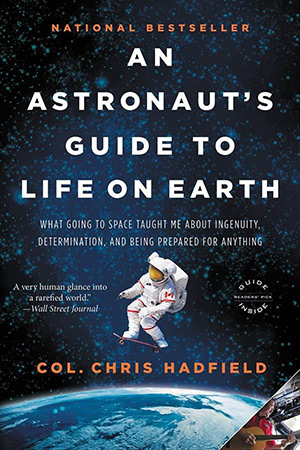Category: Non-Fiction
Reviewed by: Steve Adamczyk
From Ad Astra Fall 2014
Title: An Astronaut’s Guide to Life on Earth
Author: Col. Chris Hadfield
NSS Amazon link for this book
Format: Hardcover/Paper/Kindle/Audio
Pages: 304
Publisher: Little, Brown and Company
Date: October, 2013
Retail Price: $28.00 Hardcover
ISBN: 978-0316253017
Millions of people on Earth were fascinated and inspired when Neil Armstrong set foot on the Moon on July 20, 1969. But for Chris Hadfield growing up in Canada, it was a life changing event. At that moment he locked onto his dream to become an astronaut.
In An Astronaut’s Guide to Life on Earth, Col. Hadfield describes his life and career from youth through his final space flight aboard the International Space Station (ISS). He also gives examples and advice not only on becoming an astronaut, but on living a productive and purposeful life.
The author was raised on a farm in Canada and at 9 years old, after watching Apollo 11 land on the Moon, he decided on his life’s goal and immediately made a plan to achieve it. He learned to fly airplanes at 16. After high school, he entered military college to study mechanical engineering. Following a well-laid path, Hadfield went on to train as a Canadian fighter pilot and was accepted to the U.S. Air Force Test Pilot School at Edwards Air Force Base. After graduating as the top test pilot in 1988, he was assigned to the Patuxent River U.S. Naval Air Station, Maryland, to flight test the F-18 Hornet. He then applied, and endured a long and arduous selection process, to become a Canadian Space Agency astronaut in 1992. As a newly minted astronaut candidate assigned to NASA’s Johnson Space Center, he was given a desk next to John Young, the Moonwalker, first Space Shuttle commander, and astronaut extraordinaire. Hadfield says, “I didn’t feel like I’d finally arrived. I felt like a gnat.”
He launched on his first space flight aboard Space Shuttle Atlantis on November 12, 1995. STS-74 rendezvoused with the Russian Space Station Mir and attached a new docking module. The process required solving several problems with the hardware to successfully accomplish the installation. In overcoming adversity as an astronaut, Hadfield says, “when the stakes are high, preparation is everything,” and his basic belief is that one can never over prepare. With the loss of Apollo 1, Challenger, and Columbia, NASA has learned the hard way how much the little things matter.
His second space flight did not come until April 2001 on STS-100. After four years of training, Hadfield launched with the crew of Endeavour to install Canadarm2 on the ISS. After overcoming difficulties on their spacewalk, the robot arm was successfully attached to the ISS. When problems in space are encountered he says he does not get discouraged, and relates that “my optimism and confidence come not from feeling I’m luckier than other mortals, and they sure don’t come from visualizing victory. They’re the result of a lifetime spent visualizing defeat and figuring out how to prevent it.”
For those who see astronauts as daredevils enjoying glory and fame, he says, “every astronaut is essentially a perpetual student” and “our passion isn’t for thrills but for the grindstone, and pressing our nose to it.” His admonitions are not only for hard work and study. He reminds us all to live a balanced life, treasure our friends and family, don’t ever take others for granted, and also make time to enjoy the view.
After his second space flight, the author spent 11 years in different leadership positions, including NASA’s director of operations in Russia from 2001-2003.
Several health problems over the years threatened Hadfield’s flight status. He and his wife persevered through surgeries, medical tests, and doctor reports to maintain his assignment as commander of Expedition 35 to the ISS. On December 19, 2012, Tom Marshburn, Roman Romanenko, and Hadfield launched aboard a Soyuz to join the Expedition 34 crew on the ISS. His details of life aboard the station are so thorough that one can imagine floating weightless into the Cupola for the best view of the universe available from inside a spacecraft.
The author also describes everyday functions in space, including eating, exercising to maintain health and strength, changing clothes instead of washing, and of course the ever-popular going to the bathroom in space. There were many experiments and observations to complete, although the mission was punctuated by the high drama of performing an unscheduled extravehicular activity to repair an ammonia leak.
With help from his son and NASA, Hadfield was able to share, through social media, the importance of research being done and experiences of life on the ISS. Many of us will never forget the YouTube sensation of the guitar-playing astronaut.
After 146 days in space, Hadfield returned to Earth on the Soyuz. He describes the reentry and landing as “a wild, 54-minute tumble to Earth that feels more or less like 15 explosions followed by a car crash.” Upon landing, they were lifted from the capsule, were visited by family, began seemingly endless medical tests, and were finally allowed to savor their first shower in months.
Returning to Houston did not end the mission. It took weeks to regain strength, and medical and physical observations continued for months, even bringing on the feeling of being an “oversized lab rat.”
This autobiography is a great story of an incredible life, lived with dedication, purpose, and discipline. From growing up in rural Canada, to test pilot, space shuttle astronaut, and space station commander, the author shares the experiences, observations, and decisions that shaped an exemplary life. For an interesting memoir, teachable narrative, and inspirational story, it would be hard to find a better book than An Astronaut’s Guide to Life on Earth.
© 2014 Steve Adamczyk
Please use the NSS Amazon Link for all your book and other purchases. It helps NSS and does not cost you a cent! Bookmark this link for ALL your Amazon shopping!




















